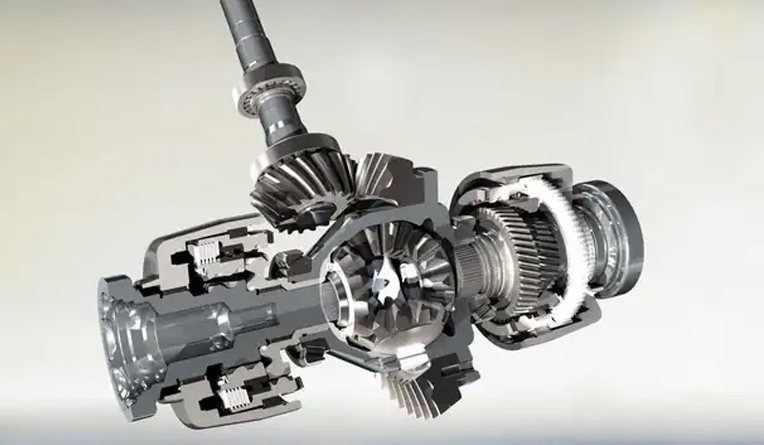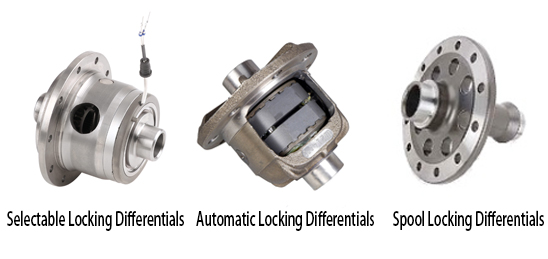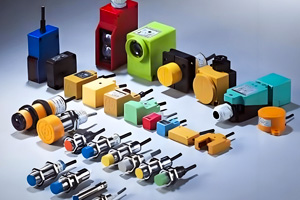What are Locking Differentials? Types, Uses, and How They Work
Author:admin Date: 2025-03-26 09:27 Views:25
Have you ever struggled to regain traction while driving in muddy conditions? If so, you are probably not using the locking differential. If you have a vehicle with this system, engage it during such tough driving conditions to see the difference.
That is not all; there is so much to locking differentials, as we will see in this guide. We discuss the types, applications, pros and cons, and other features you should know about locking differentials.
- What is a Locking Differential
- How a Locking Differential Works
- Types of Locking Differentials
- – Spool
- Applications of Locking Differentials
- Pros and Cons of Locking Differentials
- How to Use a Locking Differential
- Aftermarket vs. Factory Locking Differentials: Which One to Buy?
- How to Care and Maintain Locking Differentials
- Conclusion
What is a Locking Differential

A locking differential or locker is a mechanical component of the axle whose job is to force the wheels to turn at the same speed, ensuring better traction, especially in challenging off-road conditions.
Locking differentials are not new in vehicles. They have found favor in such applications because of how they help you get out of tricky situations. Once you lock the axle, it means all the torque is available to the wheels. This is key for improved traction.
How a Locking Differential Works
To understand how locking differentials work, we will first consider how a differential works.
Consider a time when you are cornering. During this time, the outer wheel will drive a longer distance than the inner wheel. So, more power is sent to the wheel, which makes it easy for the engine to turn. It is also called the “wheel of least resistance.” This is a suitable method for even surfaces. However, it is not the best for off-roading or challenging conditions.
You may have noticed that while offroading with 4×4 vehicles, you end up with a lot of wheel spin. The worst is when one of the tires is in the air. It will not help the vehicle move, as the diff will send more power to the freely moving wheel. Such will not get you unstuck. To resolve this, we now have the locking differential.
The locking differential allows you to lock the axles so that both wheels spin evenly. This keeps the wheel with no traction spinning in the hopes of gaining some traction, but most importantly, enough power is now available even for the wheel with traction. Unlike in the other situation above, both wheels have equal power.
Types of Locking Differentials

When looking for a rear locking differential, you will likely come across a few options in the market. The main types to expect include:
– Selectable or Manual Diff Locks
In this case, you have to turn on the locking differential manually. You can do this electronically or with pneumatic assistance.
Electronic lockers come with a magnet in the differential that attracts a series of pins or bearings once turned on to lock the axle shafts.
The air lockers (pneumatically assisted) use high-pressure air to engage the differential cluck gear, locking the shafts together.
When none of the systems are engaged, the differential works as an open differential, making the vehicle drivable on the street where favorable conditions are.
– Automatic Diff Locks
These types of differential locks are designed to automatically engage and disengage when necessary. When low traction is detected, the differential locker engages.
A simple way to determine when to engage is to check whether the RPM is higher than the preset threshold for engaging the lockers. This will ensure that you can easily maintain your traction.
However, automatic differentials tend to provide poor driving experiences on the street. Although you may not have to engage the differentials to lock manually, there are a few downsides. Some people claim that they experience unnecessary hopping and skipping with this setup.
– Spool
Spools are another alternative to the other two mentioned locking differentials. You can get either full spools or mini spools. These are usually a good option for those on a budget as they are affordable while still giving you the traction you need.
If you add the full spools, they will replace the entire carrier, while the mini spools will only replace the spider gears.
Once you have installed the spools, you cannot turn the differential locks on and off. At this point, your differential locker is always engaged, which makes street driving less enjoyable. However, offroading on a budget is a possible option.
Applications of Locking Differentials
Whether you choose an Aussie differential locker or a BMW X5 e53 locking differential, they all tend to have similar applications. Let us check them out.
– Offroad Driving
An electronic locking differential will be useful for those interested in off-road driving. Once it is engaged, you can have a better chance of going over rocky terrain, sand, deep much, and more.
You can do all this since engaging the locking differentials gets you more traction. It also maintains traction for the wheel already on the ground.
Expect to come across this type of differential in vehicles such as tow trucks, tractors, forklifts, and heavy equipment that need to maintain traction on uneven or soft surfaces.
– Sports and Racing
Do you enjoy drifting? That is one application you would find many people using in place of a limited-slip differential. This is because you get more control over the vehicle’s power key for doing the drifting maneuvers.
You can still find the locker differential being good for racing. This means you can maximize acceleration and cornering speeds. This gives the drivers better performance while hitting the corners.
– Other Uses
Military trucks will also come with locking differentials. This ensures they have enhanced traction while driving over various terrains.
Sometimes, you may come across farm equipment, such as tractors with a pedal for locking the difference. This is good considering the conditions in which a tractor is operated, especially the slippery and muddy fields.
Still, expect to come across several SUVs with the same technology. Such makes them more versatile to drive them in multiple conditions.
Pros and Cons of Locking Differentials
An auto-locking rear differential will give you the traction needed to keep the wheels rotating at the same speed; however, there can also be downsides. Let us look at the pros and cons of locking differentials.
Pros
- If you choose to get an Eaton Detroit locker differential, the result is improved traction. This means you have a bit of an advantage when you find yourself in off-road conditions.
- The Tacoma differential locker also helps maintain momentum and prevents stalling, especially in challenging terrain. This is possible because both wheels work together.
- Once you get an ARB air-locking differential, you will be more confident driving in situations with challenging conditions. It could be street driving, but there is snow or mud. At least you are sure of having an easier time navigating the conditions.
- Locking differentials are generally designed for off-road performance. That is why you will find them to have a rugged design that is vital for handling demanding conditions.
Cons
- Once you engage the locking differential, sometimes it can feel jerky while driving the vehicle at high speed.
- You are also likely to get increased tire wear since both tires are forced to turn at the same speed during cornering.
- Some people experience reduced fuel economy while driving with the diff locked over a long distance.
If you choose the locking differential, you will still have many features to experience. What is important is to consider the type of differential you decide to have in your vehicle.
How to Use a Locking Differential
It is important to always know when to engage the locking differential. This will help you choose the right time to make the vehicle more capable in various terrains.
So, when should you engage the locking differential?
The moment you start to experience loss of traction offroad, it would be time to engage it. Let us say you have found yourself driving in ice or mud, it is good to engage it.
Sometimes, it does not have to be offroad, but uneven terrain poses challenges while driving. Once you engage the locking differential, expect to have more grip, which is vital for getting you out of a rut.
Expect the 4×4 vehicles to have locking differentials. This way, you’ll always know the system is available whenever needed.
Now that you know when to engage, how do you engage the system?
It is easy. Vehicles with this system mostly have a button or switch in the center console where you can simply engage or disengage the locking differentials.
Once you press the button, check the light on the dashboard indicating that your differential is engaged.
You could still refer to the owner’s manual to see how to engage and disengage the system.
As for when to disengage, simply press the button you used to engage the locking differential. If a light on the dashboard indicates it is on, it will go off.
The automatic locking differentials can disengage automatically once you exceed a certain speed.
Aftermarket vs. Factory Locking Differentials: Which One to Buy?
The stock 4Runner locking differential is good, but an aftermarket option is also available. Should you opt for the aftermarket? What makes you choose one over the other?
Factory locking differentials offer seamless integration. As such, no modifications are necessary to install them. Also, you are expected to have more reliability with stock differentials since they are built to withstand tough conditions while off-road driving. Also, they are backed with a manufacturer’s warranty.
Factory-locking differentials are also convenient, as they are simple to operate and maintain. The switches and controls are already wired for you.
There can be a few downsides to using the factory locking differentials. One is that there is limited customization. You cannot compare the customization you get with the aftermarket options.
Still, these locking differentials are not cheap. If you get the high-trim package of vehicles that includes locking differentials, you will notice how expensive things get.
The world of aftermarket locking differentials is a big one with so much to expect. One is that you get more customization options. The main reason people use aftermarket parts is because they want more customization. This includes choosing different ratios, locking mechanisms, and the type of installation kit.
The aftermarket locking differentials are often designed to improve upon the stock option. That is why you will see the aftermarket lockers having more capabilities, such as superior off-roading and durability.
As much as the aftermarket locking differentials can be good, the installation complexity is their biggest downside. You will require a professional to do the installation for you. Still, sometimes, you may experience reliability issues if you work with companies that do not use the best materials and craftsmanship to make their locking differentials.
The choice between the two largely depends on a few factors. This includes the off-roading style, budget, how many modifications you can make to the vehicle, and installation expertise needed. These can guide you in finding the correct locking differential.
How to Care and Maintain Locking Differentials
Whether it is an Eaton locking differential or a Halo locking differential, they all need the right maintenance and care to keep them in good working condition. So, what can you do about this?
- Regular fluid checks and changes if necessary. It is recommended to change the differential fluid every 40,000 to 60,000 miles. Still, check with your owner’s manual, as it can vary from one vehicle to another. Also, make sure the differential fluid is always at the right level.
- The seals should also be inspected. Having leaky seals leads to fluid loss. If the fluid is not topped off, there is no lubrication as the locking differential is in use. Check the seals each time you service the vehicle; it is a good start to catch any leaks early.
- Proper wheel alignment is also recommended to put less pressure on the differential components. If you notice a wheel alignment issue, have it corrected immediately, as it may lead to tire wear issues in the long run.
- A professional inspection of your locking differentials can help spot potential issues you may easily miss. To keep your differentials in good condition, have them checked once or twice a year by a professional.
- You should understand when the right time to use the locking diff. You do not need to keep the diff lock engaged all the time. If you know when to use and not to use a locking differential, it will help a lot in keeping it in good condition.
Most vehicles come with an owner’s manual that provides quick maintenance tips. Follow these tips to understand how and when to care for your differential.
Conclusion
There is no doubt that right now you understand the importance of having a locking differential. What is even more crucial is knowing when to use this feature. If you ever need more traction to deal with mud or snow conditions, the locking differential can be a good feature to use. Also, ensure it is properly maintained to keep the system in good condition for the next time you need it. If your vehicle requires an upgrade, you can always consider the aftermarket options available and pick the appropriate one for you.


